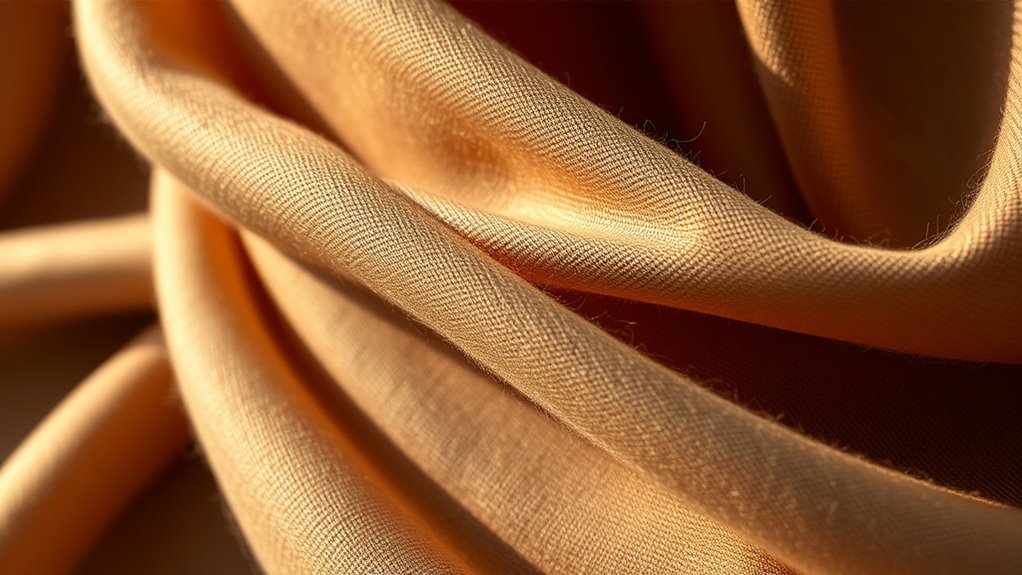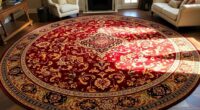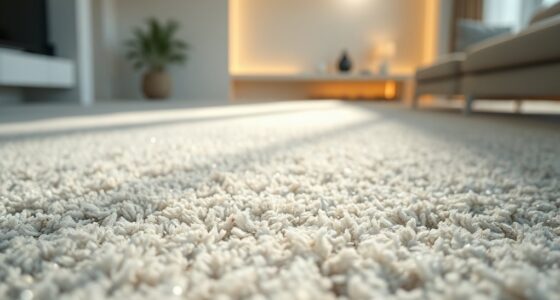Wool-silk blends are worth the premium if you value luxury, durability, and natural elegance. They combine the warmth and resilience of wool with silk’s softness and sheen, creating a comfortable, versatile fabric that ages well with proper care. Though they cost more, their sustainable sourcing and timeless appeal make them a smart investment. To discover why many consider them worth the price, explore the benefits and care tips further.
Key Takeaways
- Wool-silk blends offer luxury, softness, and durability, making them a worthwhile investment for high-end fashion and long-term wear.
- They provide superior thermal regulation and breathability, ensuring comfort across various climates.
- Proper care extends their lifespan, preserving their elegant appearance and functional qualities over time.
- Ethically sourced and sustainable options support fair labor practices and reduce environmental impact, adding value.
- Their natural sheen, resilience, and timeless appeal justify their premium price for discerning consumers.
What Are Wool‑Silk Blends Made Of?
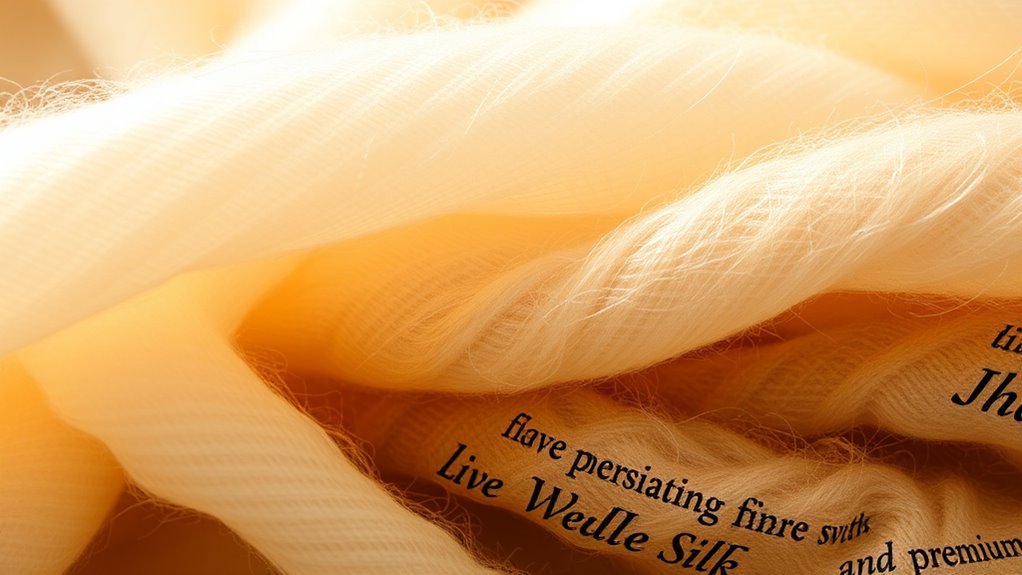
What exactly are wool-silk blends made of? These fabrics are created through fabric blending, combining wool and silk fibers to produce a unique textile. The fiber composition typically includes varying ratios, such as 70% wool and 30% silk or a balanced 50/50 mix, depending on the desired qualities. Wool provides warmth, durability, and elasticity, while silk adds softness, sheen, and a luxurious feel. This blend results in a fabric that balances the best properties of both fibers, making it versatile and elegant. Understanding the fiber composition helps you appreciate why wool-silk blends are prized for their comfort and appearance. The precise combination influences the texture, weight, and overall performance of the fabric. Additionally, the fiber blending process ensures a harmonious integration of the fibers, enhancing the fabric’s overall quality and attractiveness.
The Advantages of Wool‑Silk Fabrics

Wool-silk fabrics offer a luxurious feel and rich texture that instantly elevates your wardrobe. You’ll notice they also provide superior thermal regulation, keeping you comfortable in various climates. These qualities make wool-silk blends a smart choice for both comfort and elegance. Additionally, the use of natural fibers in these blends can enhance fabric durability and longevity over time.
Luxurious Feel and Texture
The combination of wool and silk creates a fabric that feels exceptionally soft and smooth against the skin, offering a luxurious experience every time you wear it. This blend provides a rich, silky texture combined with the warmth of wool, making it incredibly comfortable. The smooth surface enhances fabric durability, helping the material resist pilling and wear over time. Additionally, wool-silk fabrics excel in dye retention, ensuring vibrant, long-lasting colors that stay true after multiple washes. The luxurious feel isn’t just about softness—it’s also about the quality that stands out through its refined texture and resilience. When you choose wool-silk blends, you’re opting for a fabric that combines elegance with practical durability, elevating your wardrobe with a touch of understated luxury.
Superior Thermal Regulation
Combining wool and silk not only enhances the fabric’s luxurious feel but also markedly improves its ability to regulate temperature. Wool’s natural insulation and silk’s smooth, breathable fibers work together to optimize thermal comfort. This blend adapts to your body’s needs, keeping you warm in cold weather and cool when it’s hot. It also excels in moisture management, drawing sweat away from your skin and drying quickly. The table below highlights key features:
| Feature | Benefit | Result |
|---|---|---|
| Thermal regulation | Adapts to temperature changes | Consistent comfort |
| Moisture management | Wicks sweat away from skin | Keeps you dry |
| Breathability | Allows air circulation | Prevents overheating |
| Insulation | Maintains warmth without bulk | Enhanced thermal comfort |
| Quick drying | Reduces dampness and odor | Fresh feeling longer |
This synergy ensures superior thermal comfort and moisture management, making wool-silk blends a smart choice.
Cost Considerations and Price Factors
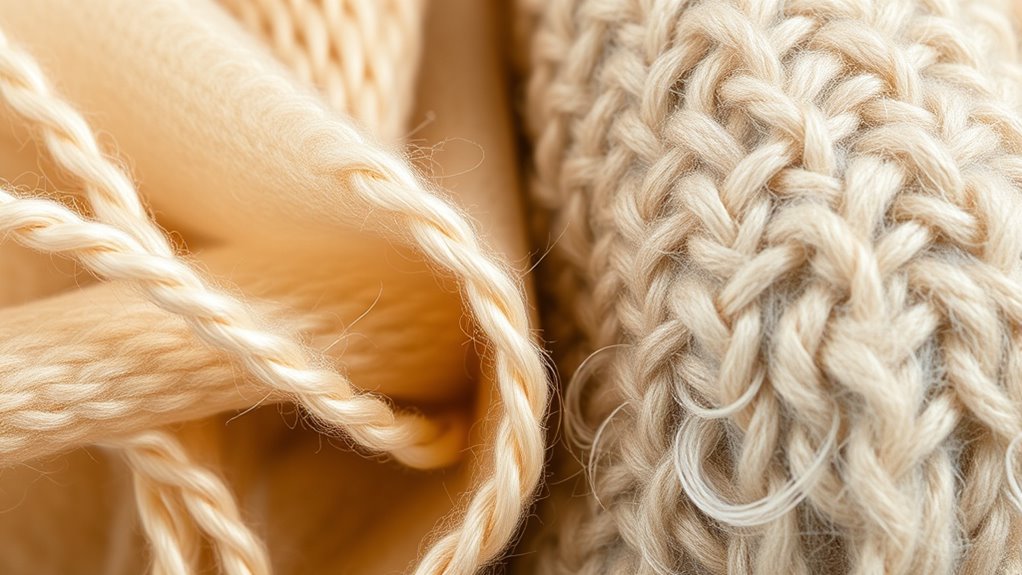
Understanding the cost of wool-silk blends involves considering both material quality and market pricing trends. Higher-quality fibers typically come with a higher price tag, affecting your overall expenses. Additionally, market fluctuations can influence prices, so staying informed helps you make better purchasing decisions. Incorporating sustainable materials can also impact the cost, as eco-friendly options may command a premium.
Material Quality and Cost
Material quality and cost substantially influence your choice of wool-silk blends. Higher-quality fabrics typically offer better fabric durability, meaning your investment lasts longer and maintains its appearance over time. Premium blends often use finer fibers, which can improve softness and overall feel. However, these benefits come at a higher price, reflecting both the quality and the labor involved. Additionally, consider the environmental impact; lower-grade blends may require less resource-intensive production, but often compromise durability and sustainability. While cheaper options might seem attractive initially, they can wear out faster, leading to more frequent replacements. Balancing cost with material quality helps ensure you choose a blend that offers good value, durability, and a responsible environmental footprint. Creativity can be cultivated through thoughtful material selection and craftsmanship, ultimately enhancing your satisfaction with the final product.
Market Pricing Dynamics
Market pricing for wool-silk blends is influenced by a variety of factors, including fiber quality, production methods, and supply chain dynamics. You’ll find that market demand plays a significant role; when demand for luxury textiles rises, prices tend to increase. Producers often adopt pricing strategies based on their target market and perceived value, which can vary from competitive to premium positioning. Limited supply or high-quality fibers can also drive prices upward, reflecting the costs involved in sourcing and processing. Additionally, fluctuations in raw material costs and transportation expenses impact overall pricing. As a consumer or retailer, understanding these dynamics helps you evaluate whether the premium for wool-silk blends aligns with their market value, ensuring you make informed purchasing decisions based on current market demand and strategic pricing considerations. For example, the horsepower of electric dirt bikes can influence the overall cost and performance, which in turn affects pricing strategies within the industry.
Comparing Wool‑Silk to Other Fabric Blends
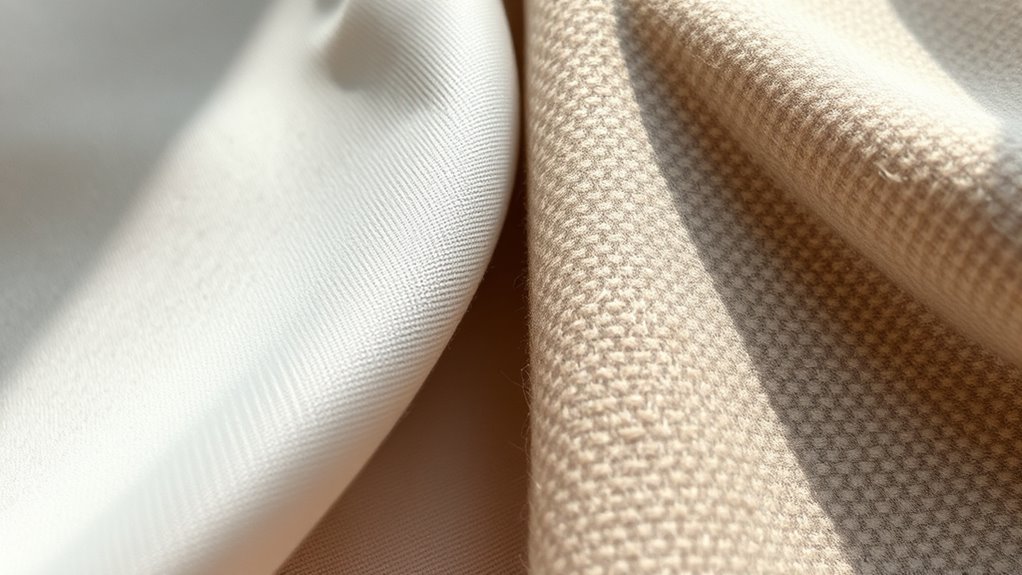
When comparing wool-silk blends to other fabric combinations, you’ll notice that they often strike a balance between luxury and durability. Wool-silk blends are prized for their soft feel, elegant appearance, and resilience, making them a popular choice in high-end fashion. Unlike synthetic blends, wool-silk fabrics tend to have fewer sustainability concerns, as they’re derived from natural fibers, though sourcing practices vary. In terms of fashion trends, wool-silk blends align with a growing emphasis on sustainable and timeless styles, appealing to consumers seeking quality over quantity. While some blends prioritize affordability or performance, wool-silk offers a premium feel with a respect for eco-conscious practices, making it a compelling choice for those who value both luxury and responsible production. Additionally, understanding the fabric care and styling requirements can help prolong the lifespan and maintain the appearance of wool-silk garments.
Tips for Caring for Wool‑Silk Garments
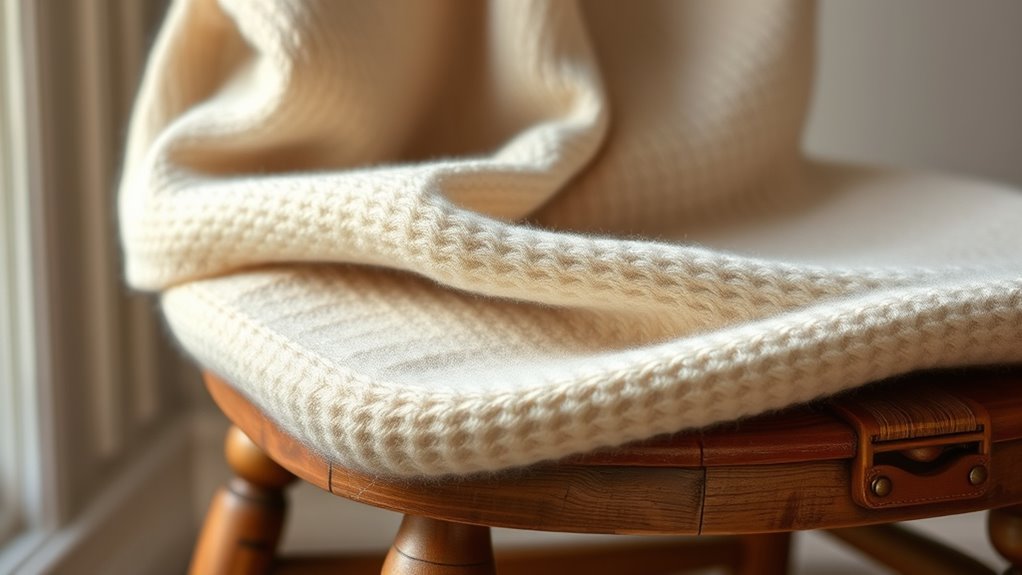
Caring for wool-silk garments requires gentle handling to preserve their luxurious feel and appearance. Your care routine should include hand washing or using a delicate cycle with cold water and mild detergent. Avoid wringing or twisting the fabric, as this can damage the fibers. Instead, gently press out excess water and lay the garment flat to dry, away from direct sunlight or heat sources. When storing wool-silk pieces, fold them carefully and keep them in a breathable container to prevent moth damage and fabric stretching. Avoid hanging these garments for long periods, as this can distort their shape. Regularly airing your items helps maintain freshness, but always follow the manufacturer’s care instructions to ensure longevity. Incorporating proper storage techniques can further extend the life of your wool-silk garments.
Is the Luxury Justified? Weighing the Benefits
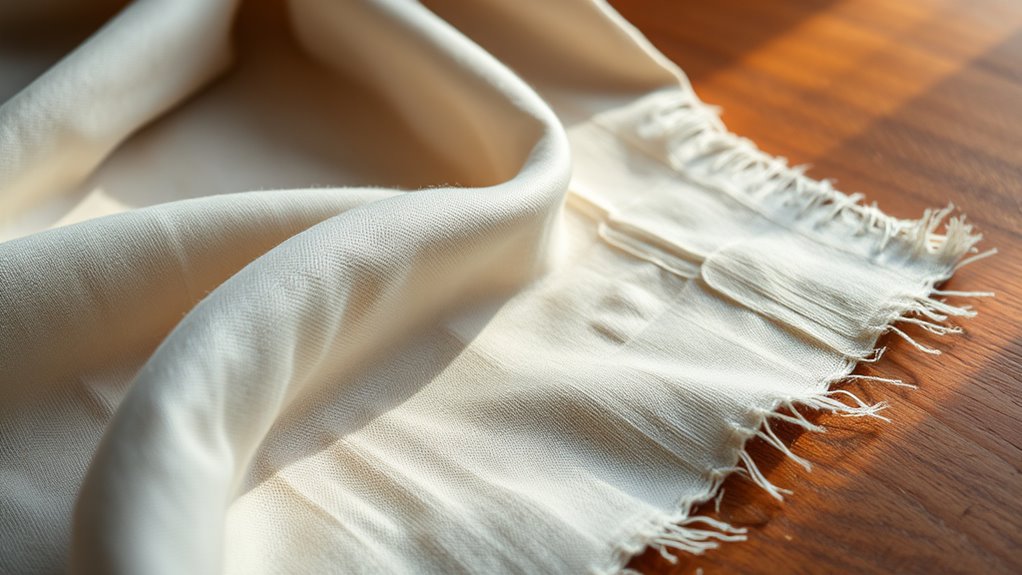
While properly caring for wool-silk garments can extend their lifespan, investing in these luxurious fabrics often raises the question of whether the added expense is truly justified. You might appreciate their softness, natural sheen, and durability, but consider if the benefits outweigh the cost. Wool-silk blends often come from ethically sourced materials, supporting fair labor and sustainable practices. They also tend to have a lower environmental impact compared to synthetic fibers, reducing pollution and waste. Visualize:
- A delicate fabric that feels like a gentle caress against your skin
- An eco-conscious choice that minimizes harm to the planet
- A timeless investment that combines natural elegance with sustainability
Additionally, understanding the Gold IRA fees and regulations can help ensure your investments are managed transparently and efficiently. Ultimately, whether the luxury is justified depends on your values and priorities in quality, ethics, and environmental responsibility.
Making an Informed Purchase Decision
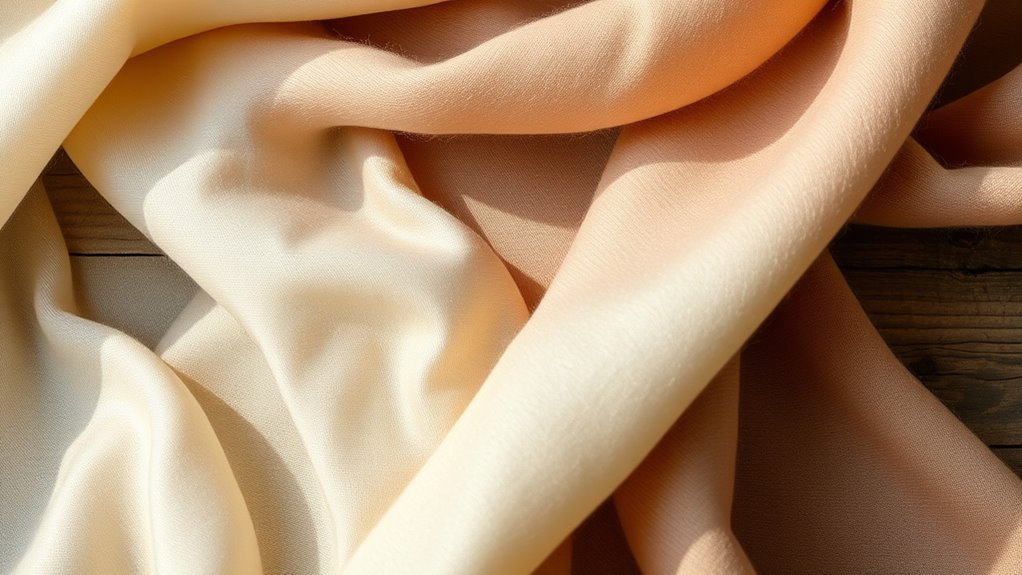
How can you guarantee that your investment in wool-silk blends is truly worthwhile? Start by researching brands that prioritize sustainable sourcing, ensuring the fibers come from environmentally responsible sources. Check for certifications or transparency about their supply chain, which indicates a commitment to reducing environmental impact. Consider whether the blend offers the durability and comfort you desire, and compare prices to determine if the premium is justified. Read reviews to gauge real-world performance and longevity. Recognizing the environmental impact of your purchase helps you make an ethical choice aligned with your values. Making an informed decision involves balancing quality, sustainability, and cost, so you feel confident that your wool-silk blend purchase is both responsible and worthwhile. Additionally, understanding the fiber blending process can help you assess the overall quality and craftsmanship involved in the product.
Frequently Asked Questions
How Do Wool-Silk Blends Perform in Different Climates?
Wool-silk blends perform well in different climates thanks to their excellent thermal regulation and moisture management. In cold weather, they insulate effectively, keeping you warm without overheating. In warmer climates, they wick moisture away from your skin, helping you stay dry and comfortable. Their natural fibers adapt to varying temperatures, making them a versatile choice for diverse conditions. You’ll find that wool-silk blends offer reliable comfort no matter the climate.
Are Wool-Silk Garments Suitable for Sensitive Skin?
If you have sensitive skin, wool-silk garments might be suitable because they often offer hypoallergenic properties that reduce irritation. Wool’s natural fibers wick moisture and regulate temperature, while silk’s smooth texture minimizes skin sensitivity issues. You’ll find these blends comfortable, breathable, and less likely to cause allergic reactions, making them a good choice if you want stylish, soft clothing that supports sensitive skin.
What Are the Environmental Impacts of Producing Wool-Silk Blends?
You might imagine wool-silk blends as a delicate dance of fibers, but their production impacts the environment. The environmental footprint involves water use, energy consumption, and chemical treatments, especially for silk. Ethical sourcing becomes essential; choosing brands that prioritize sustainable practices reduces harm. By understanding these factors, you can make conscious choices, supporting eco-friendly production and minimizing your fashion’s environmental impact.
Can Wool-Silk Fabrics Be Recycled or Sustainably Sourced?
You might wonder if wool-silk fabrics can be recycled or sustainably sourced. Unfortunately, recycling challenges arise because blending fibers makes separation difficult, limiting recyclability. However, you can look for brands committed to sustainable sourcing, like those using ethically farmed wool and silk from responsible producers. Choosing such options helps reduce environmental impact, ensuring you support eco-friendly practices even if recycling remains complex.
How Do Wool-Silk Blends Compare in Durability Over Time?
Imagine a silk scarf woven into a sturdy wool sweater—both soften with wear, like a trusted friend’s hug. Wool-silk blends typically excel in fabric softness and color retention over time, making them durable choices. Unlike pure wool or silk, their fibers work together, resisting pilling and fading, so your investment lasts longer. You’ll find your pieces maintain their charm, proving their worth through continued elegance and resilience.
Conclusion
Think of wool-silk blends like a fine symphony—each note enhances the other, creating a harmony worth the investment. You might find that their softness and durability are like a treasured heirloom, improving with time. While they come at a premium, investing in quality fabrics is like planting seeds for lasting comfort and style. So, weigh the benefits carefully—sometimes, the most beautiful melodies are worth the price of admission.
